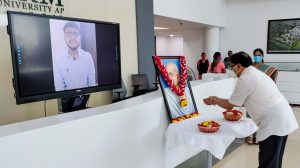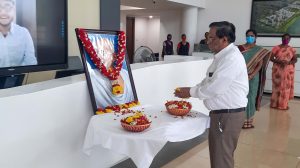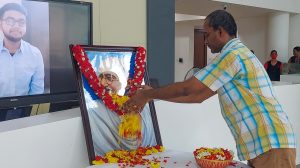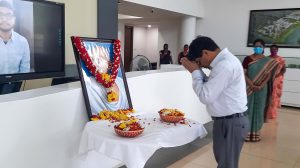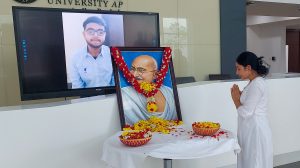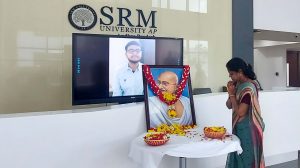SRM-AP All News
ALL News
- World’s top 2% scientists by Stanford University include faculty from SRM University-AP October 26, 2021
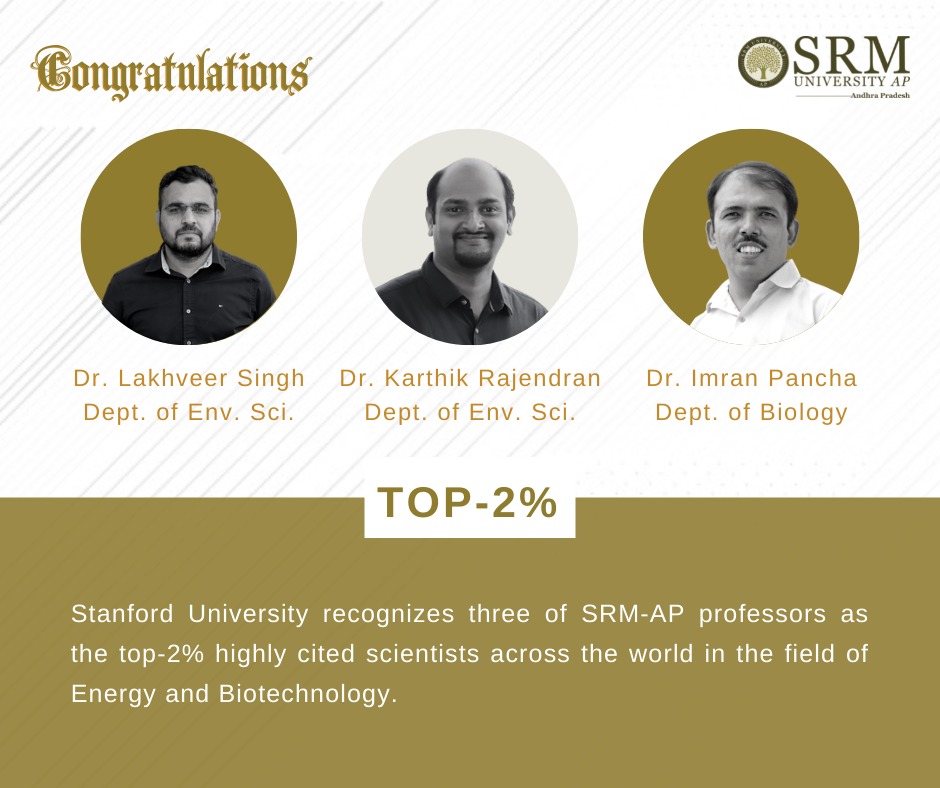 Dr Karthik Rajendran, and Dr Lakhveer Singh from the Department of Environmental Science and Dr Imran Pancha from the Department of Biological Sciences of SRM University-AP are enlisted on the global list of the top 2% of scientists, the data compiled by Stanford University.
Dr Karthik Rajendran, and Dr Lakhveer Singh from the Department of Environmental Science and Dr Imran Pancha from the Department of Biological Sciences of SRM University-AP are enlisted on the global list of the top 2% of scientists, the data compiled by Stanford University.Stanford University has identified Dr Imran Pancha as one of the 91 scientists who has excelled in research in the fields of biotechnology among all the universities in India. Dr Imran Pancha was recognised as one of the top 2% scientists in the world in the year 2020 also. Stanford University recognized 178 scientists who excelled in research in the field of energy, which includes Dr Karthik Rajendran and Dr Lakhveer Singh among the top 2 per cent of scientists. The quality of research work, its societal impact, number of publications, citations, are taken into consideration for this recognition.
University Vice-Chancellor Prof V S Rao and Pro-Vice-Chancellor Prof D Narayana Rao presented Certificates of Recognition to the three professors at a congratulatory function held at the university on Friday. “This is an admirable achievement that young faculty from a nascent University appear in the top 2% scientists of the world,” said Prof D Narayana Rao. Prof V S Rao Narayana Rao appreciated their talent and efforts. Prof Narayana Rao assured them that the university would provide the necessary comprehensive support for carrying out research in front-line and emerging areas. Prof Narayana Rao further said that he is very confident that many more faculty members of SRM University – AP, will receive such global recognition in the years to come.
Continue reading → - Exciting dream salary in dream company BARCLAYS October 22, 2021
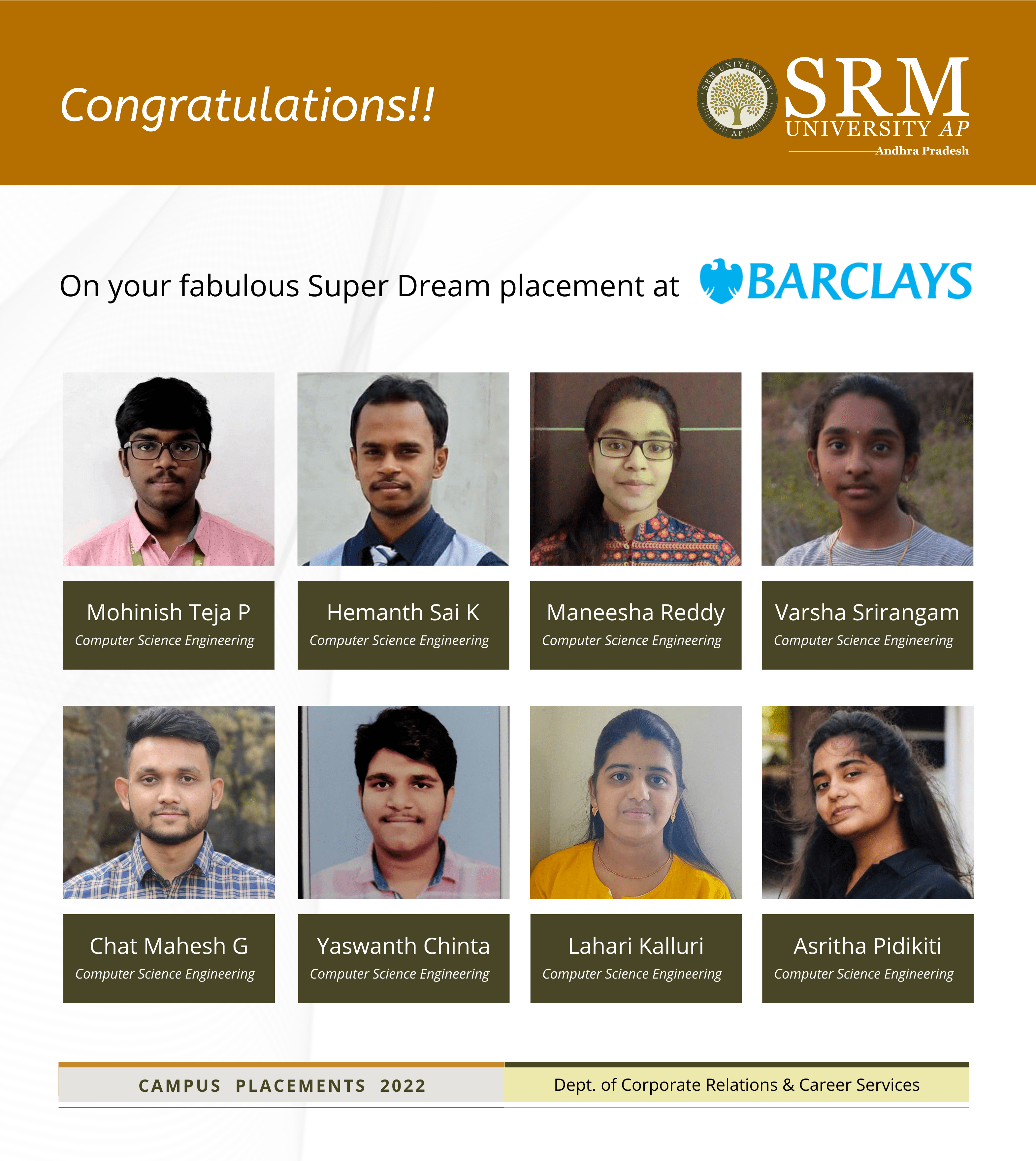 8 students with exciting job offers to their name from world-renowned Barclays Multinational Bank shine up on SRM University-AP banner. Thriving in a competitive environment and levelling themselves up with their goals, these students were able to not only show their polished skills but also their refined mannerisms at expressing it. Their smart work at making best use of the versatile courses offered to them by SRM University-AP has helped them land the job of their dreams.
8 students with exciting job offers to their name from world-renowned Barclays Multinational Bank shine up on SRM University-AP banner. Thriving in a competitive environment and levelling themselves up with their goals, these students were able to not only show their polished skills but also their refined mannerisms at expressing it. Their smart work at making best use of the versatile courses offered to them by SRM University-AP has helped them land the job of their dreams.Barclays is a coveted dream company for Engineers in India. The Placement Cell at SRM University-AP, CR&CS (Corporate Relations and Career Services) realizes that for specific job roles specific skills would have to be cultivated and the students would need outstanding training along with their academia to fill these roles. The CR&CS counsels the students accordingly so that by the time they sit for the interview they carry the confidence of being the perfect fit for the role.
Maneesha Reddy
“Stop doubting yourself, work hard and make it happen. This is what SRM University-AP taught me. The ISCP course by the CCC department included in the academics helped me become better every day and improved my skills in coding and logical thinking. The training classes provided for the placement and the talks with the experts organised by the CR&CS department helped me know the overview of the placement process. Faculty members really helped us to improve, especially our HOD, Dr Raghunathan, has been the best support to all things associated with the CSE Department. My advice to my juniors is to stay focused on your work, be confident, and follow the curriculum set by the placement department.”Gunturu Hemanth Sai Kumar
“SRM University-AP curriculum provided a wonderful environment for building up my basics and it also helped me in achieving higher CGPA. The bootcamps and ISCP classes conducted by CCC department provided me the exposure to different company specific problems and improved my problem-solving skills. Placement department also provided me with opportunities by bringing in various companies and that experience helped me clear the interviews. I even got shortlisted for interviews of Marquee and super dream companies like Wells Fargo, NielsenIQ, Navis, Sabre which provided me great exposure to interview handling skills.”Asritha Pidikiti
“SRM University-AP is a place where you can find an amalgamation of learning, fun, culture, many such life preaching activities. Various workshops and sessions that were held in the University, improved my technical as well as interpersonal skills. My knowledge and confidence go a boost after coming here. SRM University-AP has given me a chance to participate in various committees which helped me to broaden my network. The placement cell has excellent policies and has exceptionally helped me build an industry-ready profile, by arranging seminars and holding aptitude- development lectures.”Chinta Yaswanth
“I am very glad to start my career with Barclays This could come to pass because CR&CS dept supported us a lot by conducting multiple mock tests. Especially, thanks to the company specific sessions before the drive. These sessions before the drive made all the difference and assured us to face an interview. I whole-heartedly appreciate the virtual help desk despite of the covid situation. I would suggest my juniors to be good at their basics and follow the inputs given by placement team.”Kalluri Lahari
“You never change your life until you step out of your comfort zone; change begins at the end of your comfort zone.
“I still remember when I joined this university, being a person who used to be shy and introvert, and today, I am here holding an offer would not have been possible without the support from SRM University-AP. The coursework provided by CR&CS department, CDC and domain training helped me to achieve this offer. The CDC department guidance assisted us in improving communication skills and teamwork. Approximately 65 companies lined up for recruitment in a month. SRM University provided us with countless opportunities to fulfil our goals. My advice for the juniors would be to not postpone everything to the last-minute because this might stop you from achieving your dreams.”Srirangam Varsha
“The curriculum containing industry specific training, mock interviews and group discussions along with company specific training made it easier for us throughout the placement drive. We were familiar with the concepts asked in our coding and interview rounds thanks to the training sessions provided by the CR&CS department. The encouragement I received from my faculty and mentor really helped me when I was at my lowest. I would like to take this chance to thank all my faculty, seniors and CR&CS department because of whose help I did not feel any burden throughout my placement drive and achieved great results. I would suggest to my juniors to take advantage of inputs provided by management to fulfil your dreams and achieve higher heights.”Paturi Mohinish Teja
“I am very happy to get placed at Barclays. I used to dream about getting placed at a FinTech institution and am very glad to achieve it. Curriculum at SRM University-AP helped me in learning all the required computer fundamentals. CCC training organised by the placement department has helped me a lot during my preparation for placements and interviews. I have been part of Next Tech Lab, which helped me learn a lot of things and build many projects. These projects helped me in Interview. My advice to Juniors would be to build a strong portfolio and never give up in the middle.”SRM University-AP is proud of their achievements and would like to wish them all the success in their lives as their alma-mater.
Continue reading → - Securing Online Payments made through Wearable Devices October 20, 2021
Smart devices and Internet of Things (IoT) are growing in importance every day and so do our security concerns about using them for our financial transactions. As we carry the world with us through wearable technology, Dr Sriramulu Bojjagani, Assistant Professor, Department of Computer Science Engineering works towards making wearable devices more secure.
With a thriving interest in Cyber Security, Formal Verification Methods and Vulnerability Analysis and Penetration Testing, Dr Bojjagani has recently published his paper on “A Secure IoT-based Micro-payment Protocol for Wearable Devices” in Peer-to-Peer Networking and Applications (PPNA), Springer.DOI: 10.1007/s12083-021-01242-y
Abstract:
Wearable devices are one of the parts of the essential cost of goods sold (COGS) in the wheel of the Internet of things (IoT), contributing towards a potential impact in the finance and banking sectors. There is a need for lightweight cryptography mechanisms for IoT devices because these are resource constraints. This paper introduces a novel approach to an IoT-based micro-payment protocol in a wearable device’s environment. This payment model uses “elliptic curve integrated encryption scheme (ECIES)” for encryption and decryption of the communicating messages between various entities. The proposed protocol allows the customer to buy the goods using a wearable device and send the mobile application’s confidential payment information. The application creates a secure session between the customer, banks, and merchant. The static security analysis and informal security methods indicate that the proposed protocol is withstanding the various security vulnerabilities involved in mobile payments. For logical verification of the correctness of security properties using the formal way of “Burrows-Abadi-Needham (BAN)” logic confirms the proposed protocol’s accuracy. The practical simulation and validation using the Scyther and Tamarin tool ensure the absence of security attacks in our scheme. Finally, the performance analysis based on cryptography features and computational overhead of related approaches specify that the proposed micro-payment protocol for wearable devices is secure and efficient.
Architecture for wearable devices:
The architecture for wearable devices is shown in Fig. 1. It consists of six types of entities, such as Issuer bank (IB), acquirer bank (AB), payment gateway (PG), a certification authority (CA), mobile terminal, and wearable sensing devices. The person using various wearable devices such as a smartwatch, smart wristband, smart glass, etc. In the architecture, a wearable device is connected to the mobile terminal through NFC. An app is running on a mobile device. Wearable devices are resource constraints because they have limited computing capabilities regarding battery, display, storage, and processing compared to a mobile terminal (smartphone). Hence, NFC is used to pair the wearable device and mobile terminal for transmitting public messages. Before conducting any transaction with the merchant, the customer and merchant should register their mobile numbers with the bank.
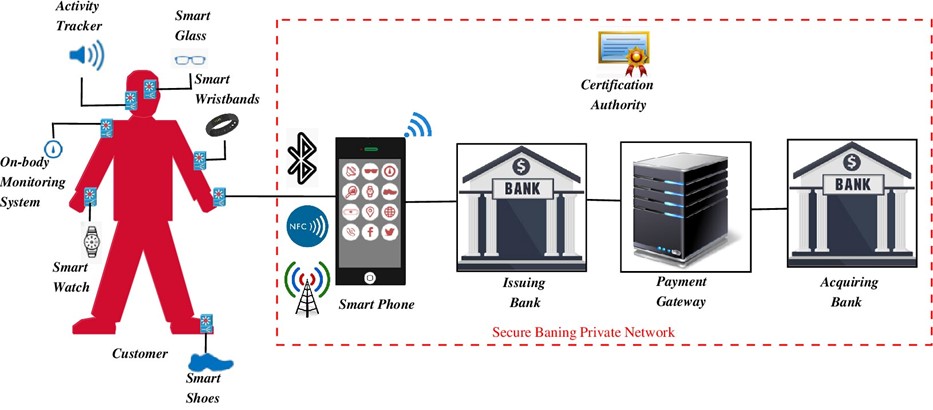
Fig. 1. Architecture for wearable devices
The customer can place an order with the merchant using the following steps and the complete messages flow in the proposed protocol is shown shown in the Figure.
● The customer places an order for an item through a wearable device.
● The request is transferred to the mobile app. The mobile app verifies the user authentication.
● After a successful authentication request, the app forwarded the request to the issuing bank for payment verification.
● The customer also sends a payment request for a deduction of the amount from his/her issuing bank.
● Once the bank validates the customer data in terms of sufficient funds available and user’s integrity. The issuing bank routes the transaction to the payment gateway through a secure network.
● In this step, the payment gateway verified the customer payment order and transferred it to the acquiring bank.
● If all the verifications are successful, then the transaction amount is then debited from the issuing bank and credited to the merchants’ acquiring bank.

Application demonstration:
As we know, most wearable devices run the Android operating system. The proposed framework developed as an Android application package (APK) file run in an Android wearable emulator, but we have operated in the Samsung Galaxy Note-2 device due to limits of the screen device and lack of environment. First, it needs to install the APK file and start running the app. Before running the app, some points need to be considered, such as the following:
● The company voice gateway provided for the service of an SMS gateway connected to Xeon server and assigned us a shortcode 56677.
● The payment gateway switch is used to communicate with the customer and merchant bank accounts.
● Two mobile numbers are registered with the banks and telecom operations, and it is used for SMS service.
● The deployed decryption web application on the Xeon server.
● HTTPS connection is used between voice gateway and Xeon server established Indian financial network (INFINET) link between server and bank.
We have not mentioned all the screenshots for the app from starting the login and authentication phase, but the protocol requires the essential information only shown in the screenshot. We didn’t mention the banks considered for implementing the micro-payment protocol for security and reputation reasons.
The proposed protocol action is as follows:
Step 1: The customer x runs a wearable application to enter Wearable-id, mobile number, pin and amount and sends an encrypted message to the Xeon server via short-code 56677. To encrypt the message, the customer may choose any one of the ECC curves as shown in Fig. 2.
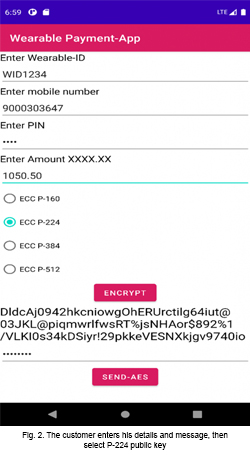
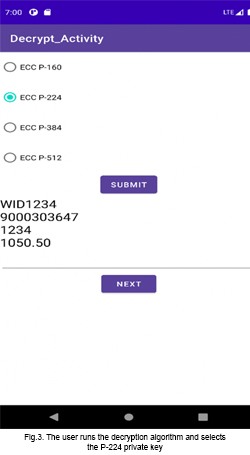
Step 2: The SMS gateway receives the encrypted SMS, which is delivered to the server
Step 3: The server receives the encrypted SMS and executes the decryption application. Next, the user runs decryption activity and selects the P-224 private key. After decryption, the message is shown in Fig. 3.
Step 4: After the message is decrypted, the user presses the “Next” button to communicate with the payment gateway.
Step 5: Now, the merchant fills in the remaining fields of merchant UPI-id, mobile number, and purpose of payment and then selects any payment gateway as shown in Fig. 4.

Fig. 4: The merchant enters the details and sends to any payment server
Dr Bojjagani’s research will further refine the parameters of security in IoT enabling wearable devices to become smarter and safer.
- To make the proposed protocols more secure can add biometric-based authentication can be added.
- The future directions of the proposed framework fit only for micro-payments. In future, we have upgraded to credit card/debit card payments to enhance the proposed framework for macro-payments.
- Impact of Surface Chemistry on the Excited State Interactions of CsPbBr3 October 20, 2021
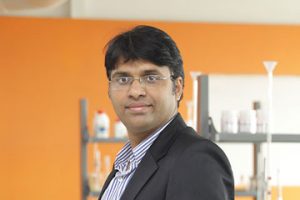 Dr Nimai Mishra, Assistant Professor, Department of Chemistry, SRM University-AP along with his team comprising of his PhD scholars Mr. Syed Akhil, Ms. V.G.Vasavi Dutt, and Mr Rahul Singh have published a research article titled “Surface-State-Mediated Interfacial Hole Transfer Dynamics Between CsPbBr3 Perovskite Nanocrystals and Phenothiazine Redox Couple” in The Journal of Physical Chemistry-C, published by The American Chemical Society with an impact factor of ~4.126.
Dr Nimai Mishra, Assistant Professor, Department of Chemistry, SRM University-AP along with his team comprising of his PhD scholars Mr. Syed Akhil, Ms. V.G.Vasavi Dutt, and Mr Rahul Singh have published a research article titled “Surface-State-Mediated Interfacial Hole Transfer Dynamics Between CsPbBr3 Perovskite Nanocrystals and Phenothiazine Redox Couple” in The Journal of Physical Chemistry-C, published by The American Chemical Society with an impact factor of ~4.126.Dr Mishra’s research interests lie in Semiconductor nanocrystals, Core/shell branched structures, Nanowires, Perovskite nanocrystals and Optoelectronic device fabrication. He studied the role of surface chemistry for improving excited state hole transfer from CsPbBr3 nanocrystals to an acceptor, potentially applicable for photocatalytic applications.
About the research:
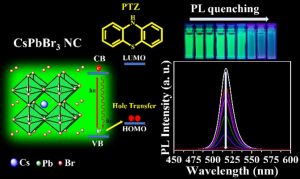 Recently, caesium lead bromide (CsPbBr3) perovskite nanocrystals (PNCs) gained enormous attention for designing photocatalytic reactions because of their photocatalytic properties. But the surface chemistry of nanocrystals is often ignored which dictate the excited state interactions of these semiconductor nanocrystals with the charge shuttling redox-active molecules. In this work, we have explored the impact of CsPbBr3 perovskite nanocrystals with the three different surface chemistries on the excited state interactions with the standard hole acceptor phenothiazine molecule. From the steady PL-lifetime decay measurements we have calculated the photoinduced hole transfer (PHT). In the amine-free PNCs case, PHT is 6 times higher than the conventional amine capped ligands. Using the lifetime fast component (1) rate constants, we have calculated the hole transfer constant (kht) which is 3.942 × 108 s-1 and it is 4 times higher in amine-free ligands when compared with conventional amine ligands system.
Recently, caesium lead bromide (CsPbBr3) perovskite nanocrystals (PNCs) gained enormous attention for designing photocatalytic reactions because of their photocatalytic properties. But the surface chemistry of nanocrystals is often ignored which dictate the excited state interactions of these semiconductor nanocrystals with the charge shuttling redox-active molecules. In this work, we have explored the impact of CsPbBr3 perovskite nanocrystals with the three different surface chemistries on the excited state interactions with the standard hole acceptor phenothiazine molecule. From the steady PL-lifetime decay measurements we have calculated the photoinduced hole transfer (PHT). In the amine-free PNCs case, PHT is 6 times higher than the conventional amine capped ligands. Using the lifetime fast component (1) rate constants, we have calculated the hole transfer constant (kht) which is 3.942 × 108 s-1 and it is 4 times higher in amine-free ligands when compared with conventional amine ligands system.According to Dr Nimai Mishra, the most important contribution of this research is that these results highlight the impact of surface chemistry on the excited state interactions of CsPbBr3 PNCs and conclude amine-free PNCs could be an ideal candidate for photocatalytic reactions.
Read the full paper: https://pubs.acs.org/doi/10.1021/acs.jpcc.1c07129
Continue reading → - Better Kinetics with MXene-based Electrocatalysts in Fuel Cells October 8, 2021
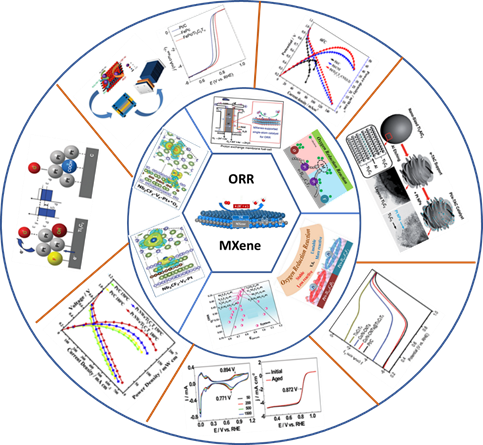 A cutting-edge research paper on MXene-based electrocatalysts for fuel cells has been published by Dr Lakhveer Singh of the Department of Environmental Sciences. In the journal of Advanced Materials Interfaces, Impact factor 6.14, his paper, titled “Recent Advances on MXene-Based Electrocatalysts toward Oxygen Reduction Reaction: A Focused Review”, has been published in collaboration with Dr S. G. Peera and Dr. T. G. Lee from the Department of Environmental Science and Engineering Keimyung University Daegu 42602, Republic of Korea.
A cutting-edge research paper on MXene-based electrocatalysts for fuel cells has been published by Dr Lakhveer Singh of the Department of Environmental Sciences. In the journal of Advanced Materials Interfaces, Impact factor 6.14, his paper, titled “Recent Advances on MXene-Based Electrocatalysts toward Oxygen Reduction Reaction: A Focused Review”, has been published in collaboration with Dr S. G. Peera and Dr. T. G. Lee from the Department of Environmental Science and Engineering Keimyung University Daegu 42602, Republic of Korea.Oxygen reduction reaction (ORR) takes place in the fuel cells. Improving the kinetics of the reaction would be a major step in improving the efficiency of the fuel cells. Extensive studies have been done to find cathode catalysts that are both highly active and also maintain stability in a corrosive environment. Recent research has been leaning towards 2D materials owing to the larger surface area they provide for catalyst dispersion. MXene-based catalysts have become popular due to their impressive electrical conductivity as well as their thermal and chemical stability.
A summary of Dr Singh’s paper:
MXene, a novel transition metal carbide and/or nitride based two-dimensional material has been gaining a considerable interest in the field of energy storage and conversion, due to their unique layered structure, electronic properties, and surface chemistry, that are beneficial for various electrochemical reactions. Most of the MXenes research done so far is in the field of supercapacitors, batteries, overall water splitting, and other catalytic applications. The research done on fuel cell cathodic oxygen reduction reaction (ORR) is scarce. There is a need for intensive review on Mxenes. Uniquely, this review article describes the ORR catalysis of MXene based catalysts both in theoretical and experimental view.
In future they plan to work on investigations on theoretical and computational screening to elucidate the ORR mechanism, stability, and strategies for improving the electrocatalytic activity of MXene catalysts; these studies can serve as a guide for experimentalists, especially for selecting optimal catalyst compositions.
Continue reading → - Pavan Mohan wins TATA InnoVerse SolverHunt Challenge bagging Rs.25,000 October 7, 2021
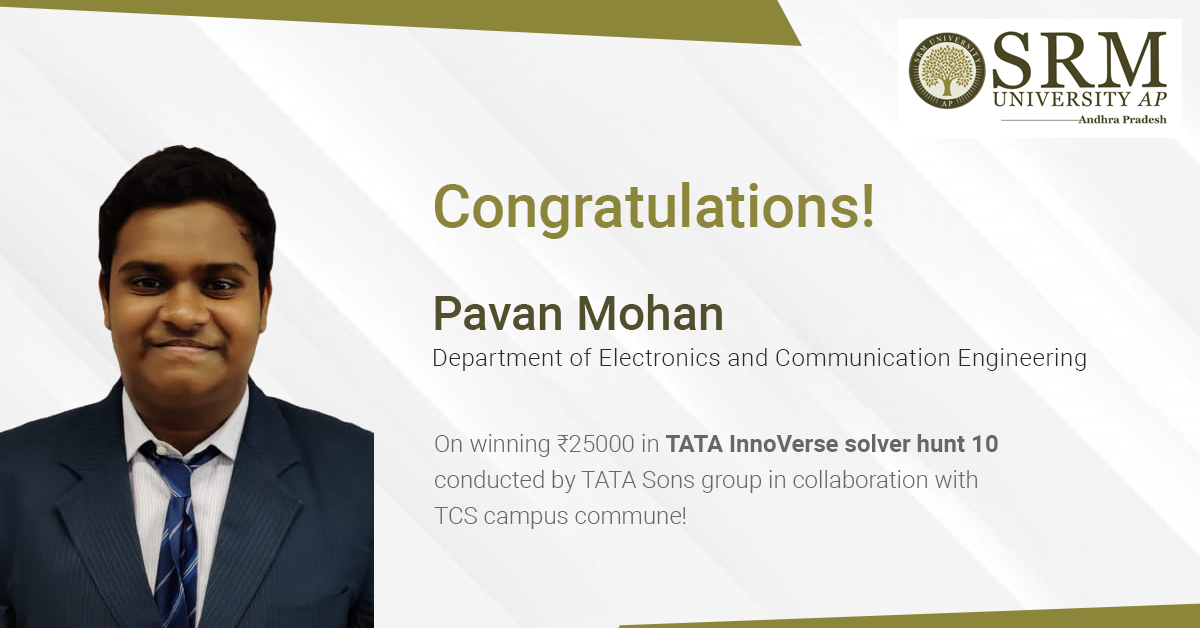 SRM University-AP is proud to announce that Pavan Mohan Neelamraju, a student of the Department of Electronics and Communication Engineering (ECE) has shown extraordinary problem-solving abilities and won the TATA InnoVerse SolverHunt 10 and has been rewarded with Rs. 25,000.
SRM University-AP is proud to announce that Pavan Mohan Neelamraju, a student of the Department of Electronics and Communication Engineering (ECE) has shown extraordinary problem-solving abilities and won the TATA InnoVerse SolverHunt 10 and has been rewarded with Rs. 25,000.The TATA InnoVerse SolverHunt poses challenges to aspiring innovative students in the fields of scientific and technological research. The students are required to come up with solutions individually and the most viable solutions are rewarded with exciting cash prizes, certificates of recognition and an invaluable opportunity to learn from experts in the industry.
Pavan’s challenge in the TATA InnoVerse SolverHunt was to classify steel wire bundles based on their shining appearance. Pavan developed an algorithm which quantified the gloss in the image using image processing and machine learning techniques. The algorithm went through three rounds of rigorous evaluation before being declared best.
Though Pavan worked on his solutions all by himself adhering to the guidelines of the TATA InnoVerse SolverHunt, he believes his vastly flexible course choices helped him a lot. The knowledge and perspective he gained in “Artificial Intelligence and Machine Learning” coupled with the hands-on experience he acquired while working on cutting edge technology as a part of Next Tech Lab at SRM AP enabled him to make vital winning decisions.
“The academic work has actually helped me to think out of the box and to imagine a wide range of possibilities to a single problem,” Pavan thanked Dr Ramesh (HOD ECE) and Prof. Siva Shankar along with the faculty of ECE Department for grooming him. In industrial problems such as the ones provided by TATA InnoVerse SolverHunt Pavan was able to implement machine learning and image processing which he had learnt in classroom.
We, the SRM Family, wish Pavan luck for all his future endeavours and plans which include obtaining a doctorate degree as well as working in teaching and research fields. Winning TATA InnoVerse SolverHunt is the first step on the path of recognition for him. We are extremely pleased that he could serve as an inspiration to all the students out there.
Continue reading → - C&EN features Dr Anil’s Research on sustainable biofilm October 6, 2021
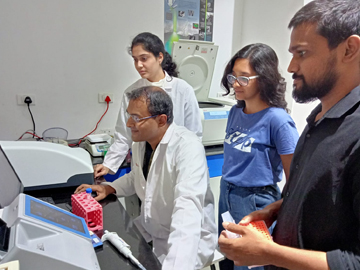 Dr Anil K Suresh’s innovative research has been brought into the limelight by the revered weekly magazine Chemical & Engineering News (C&EN), published by the American Chemical Society. Dr Anil K Suresh, Associate Professor, Department of Biological Sciences, and his team from SRM University-AP recently developed a see-through transparent (with 85% above transmittance) biotemplate which they derived from the fish scale wastes to substitute the extensive usage of eco-unfriendly disposal plastic cuvettes for UV-Visible Spectroscopy measurements in the spectrum of 350-900 nm.
Dr Anil K Suresh’s innovative research has been brought into the limelight by the revered weekly magazine Chemical & Engineering News (C&EN), published by the American Chemical Society. Dr Anil K Suresh, Associate Professor, Department of Biological Sciences, and his team from SRM University-AP recently developed a see-through transparent (with 85% above transmittance) biotemplate which they derived from the fish scale wastes to substitute the extensive usage of eco-unfriendly disposal plastic cuvettes for UV-Visible Spectroscopy measurements in the spectrum of 350-900 nm.UV-Vis spectroscopy is a versatile analytical tool used to examine the nature of various synthetic, biological and clinical molecules for pharmaceutical and environmental applications. The team members demonstrated the practical on-biotemplate analysis of diverse analytes such as DNA, proteins, nanoparticles, organic dyes, bacteria, BSA assay and dye-degradations. Dr Anil K Suresh owns the copyrights for this pathbreaking invention by being granted an Indian patent. This work was published in the prestigious Journal “Green Chemistry” by the Royal Society of Chemistry. Read the full paper here.
Chemical & Engineering News (C&EN), which is widely known to feature articles of the best professional and technical innovative research work and analysis in the fields of chemistry and chemical engineering, has acknowledged Dr Anil’s research by allowing it little room in their magazine in Volume 99, Issue 36 (Read the news here). C&EN includes information on recent news and research in chemistry and chemical engineering along with career and employment information, business and industry news, government and policy news, funding in these fields, and special reports.
“The magazine is very celebrated among researchers across the world. It is a great honour for my team and me to be featured in the magazine. This news magazine usually picks only top nature cell science publications among thousands, and My team and I are feeling great to be one of them,” said Dr Anil. Dr Anil further said that it would not be possible to carry out such prominent research work in a newly built establishment without the constant support from the management of SRM University-AP, Andhra Pradesh. He has profoundly thanked Dr P Sathyanarayanan, President; Prof V S Rao, Vice-Chancellor; Prof D Narayana Rao, Pro-Vice-Chancellor, for their kind help and cooperation.
The University Management congratulated Dr Anil K Suresh on his achievement. Dr Sathyanarayanan said, “It is indeed a proud moment for the university to be featured on C&EN. I compliment Dr Anil and his team on their tireless work.” “Dr Anil and his team have executed an extraordinary work towards a green environment which should be emphasised in international journals. The Team’s dedication towards their research is commendable,” said Prof V S Rao. Prof D Narayana Rao opined that Dr Anil K Suresh is one of the most talented young biologists in the nation. “I have personally known him for some time being and working with him for a few years. Dr Anil is devoted biologist and pride of the university,” asserted Prof D Narayana Rao.
Continue reading → - Dr Sumit Kumar publishes two research articles in reputed journals October 6, 2021
 Dr Sumit Kumar, Assistant Professor from the Department of Management has recently published two papers in highly reputed Scopus indexed journals. The paper titled “Managing employees’ turnover: findings from AHP model” is published in the International Journal of Economics & Business Research and “Economic Prosperity and Environmental Sustainability: Role of Infrastructure Development” in the Indian Journal of Ecology.
Dr Sumit Kumar, Assistant Professor from the Department of Management has recently published two papers in highly reputed Scopus indexed journals. The paper titled “Managing employees’ turnover: findings from AHP model” is published in the International Journal of Economics & Business Research and “Economic Prosperity and Environmental Sustainability: Role of Infrastructure Development” in the Indian Journal of Ecology.Managing employees’ turnover: findings from AHP model is an attempt to compare and evaluate the relative significance of myriad HR issues leading to better management of the employee turnover problem. The research questions explored and examined in this study provided deeper insights and a better understanding of the problem of retaining and nurturing human capital and have relevant implications for scholars, policymakers, and retail organisations. An important theoretical contribution of the study is in enriching the literature on employee retention in the organised retail sector. The practical implications of this study mainly emanate from the results of this study and are related to practices of managing people at work. The findings of the study can be effectively used to design a robust retention policy.
Read the full paper hereThe second paper titled Economic Prosperity and Environmental Sustainability: Role of Infrastructure Development is co-authored by A. Mishra, M. Sharma, and et. al. This pragmatic investigation strives to divulge the relationship between infrastructure expansion and environmental defilement in the Indian outlook by realistically exerting panel data of 10 Indian states, which contributes 70 per cent of the total national population. The precise outcome of the investigation demonstrates that some proxies of infrastructure improvement such as electric capacity, railways network, road network and telecommunication have linkage with the air quality index in India.
Dr Sumit Kumar is an Assistant Professor in the School of Entrepreneurship and Management Studies, SRM University AP, Andhra Pradesh, India. He has done his PhD from the Indian Institute of Technology (Indian School of Mines), Dhanbad in Marketing Management. He has eight years of rich experience in the industry, research, and academia. His research, interests focus on the areas of marketing and consumer behaviour, green products, private label brands (PLB), virtual retail environment and online retail. He has also presented papers at premier national and international conferences. He authored and co-authored several research articles in reputed international and national journals.
Continue reading → - Paying tribute to the father of the nation on his 152nd birth anniversary October 5, 2021
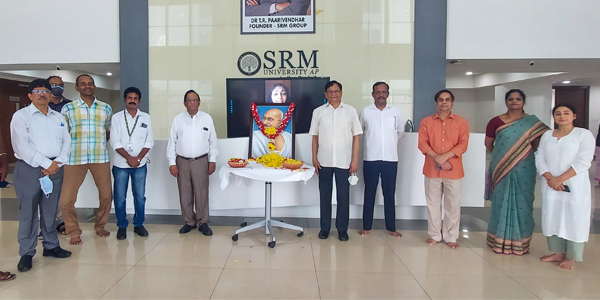 SRM University-AP paid floral tribute to Mahatma Gandhi on his 152nd birth anniversary on October 2, 2021, at the university campus. Vice-Chancellor, Prof V S Rao; Pro-Vice-Chancellor, Prof D Narayana Rao; Director- Campus Life Management, Wg Cmdr Venkataachalam Sekkappan; and Assistant Director- Student Affairs, Ms Revathi Balakrishnan talked about the venerable life of Mahatma that inspired civil rights movements across the world.
SRM University-AP paid floral tribute to Mahatma Gandhi on his 152nd birth anniversary on October 2, 2021, at the university campus. Vice-Chancellor, Prof V S Rao; Pro-Vice-Chancellor, Prof D Narayana Rao; Director- Campus Life Management, Wg Cmdr Venkataachalam Sekkappan; and Assistant Director- Student Affairs, Ms Revathi Balakrishnan talked about the venerable life of Mahatma that inspired civil rights movements across the world.Every year on Mahatma Gandhi’s birthday, prayer sessions and tributes are held across the country. Mahatma Gandhi, who was instrumental in India’s freedom, is recognised for his nonviolence and truth ideals, which he began to practise early in his life. The ideals of Mahatma Gandhi motivated the freedom fighters to think of “Swaraj” and quietly work for it. Non-violence was his motto and India could free herself from colonial authority without violence because of his ideals.
Continue reading → - IIT Indore Selected Akash Yadav for M-Tech Programme with Scholarship September 30, 2021
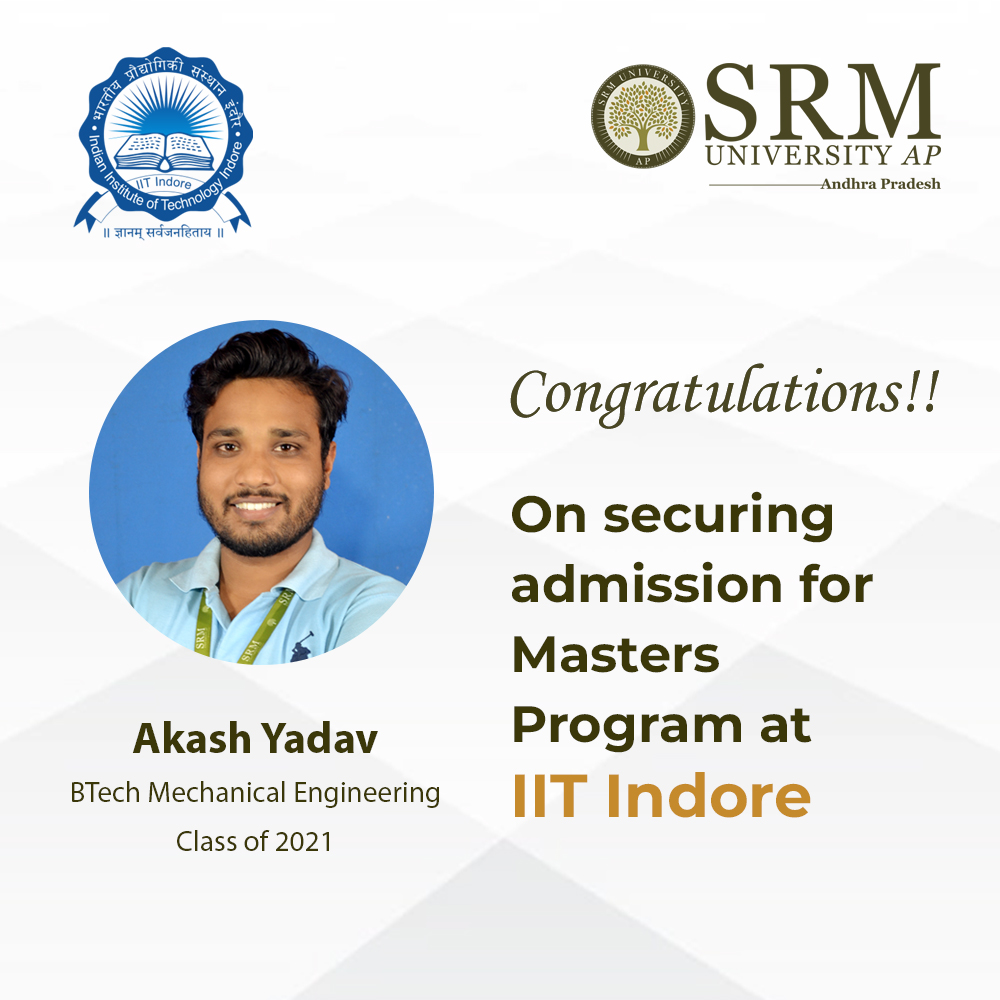 SRM University AP is happy to inform everyone that IIT Indore selected Akash Yadav of our Mechanical Engineering Department class of 2021 into a coveted Master’s Program. Akash is excited to start his M-Tech journey in Production and Industrial Engineering Program at IIT Indore in Madhya Pradesh.
SRM University AP is happy to inform everyone that IIT Indore selected Akash Yadav of our Mechanical Engineering Department class of 2021 into a coveted Master’s Program. Akash is excited to start his M-Tech journey in Production and Industrial Engineering Program at IIT Indore in Madhya Pradesh.Indian Institute of Technology, Indore or IIT Indore was established by the Government of India for Engineering Studies to provide research-based education. It has become one of the pioneer research institutes in the country and is known for its innovation driven research and entrepreneurship.
Getting selected into IIT Indore is not the first of Akash’s many successes. Akash hails from Nepal and is a recipient of a prestigious scholarship under “Dr. Homi Jahangir Bhabha Scholarship Scheme” from Embassy of India, Kathmandu for his higher education. This scheme provides full scholarship to all students and even provides stipend to selected students.
Akash showed tremendous potential and was a feather in the cap of SRM University AP even before getting selected for M-Tech at IIT Indore. Along with pursuing his Bachelor’s degree in Mechanical Engineering, he completed four projects in four years in our labs. His project titled “Experimental Investigation of laminar length for Non-impinging Submerged Jets” was also awarded with a gold medal.
“I cannot forget the conscientious support of my mentors Dr. Prakash Jadhav and Dr. Surfaraz S Halkarni from Department of Mechanical Engineering during my projects.” Akash said, “Research based learning at SRM University AP, is the key to my success.”
We, the SRM Family, wish Akash all the success in his chosen path and are proud to share the table with IIT Indore as his alma matres. We are pleased that our research facilities could accommodate his innovative mind in the classroom and his ideas and designs in our laboratories.
Continue reading →


